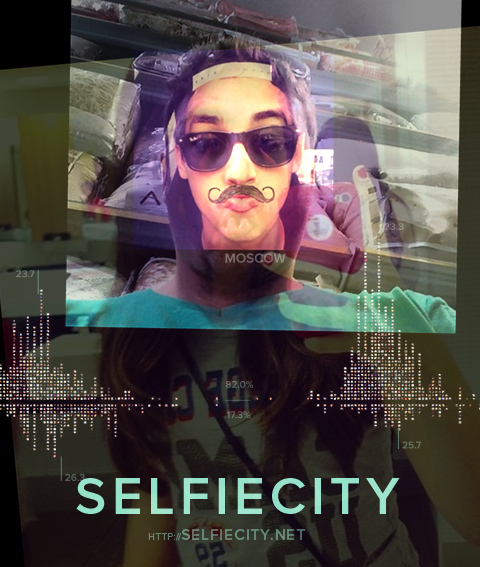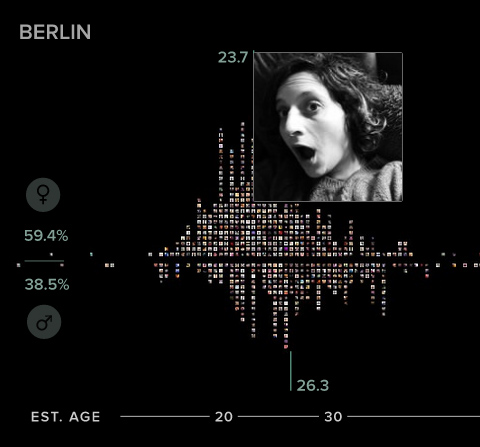Selfiecity
The selfiecity project has launched earlier this week, and boy, it has hit a nerve. We had 10’000s of visitors in the first few days, and hundreds of articles and posts linking to the project.
It has been a great pleasure and stimulation to work with an exceptionally interesting team on this: from Lev Manovich (a legend in the media theory and digital humanities scene) over my brilliant — and, luckily, by now, frequent — collaborator Dominikus Baur to Daniel Goddemeyer, Mehrdad Yazdani and many other talented folks.
The project investigates a seemingly mundane topic — selfies (#omg #wtf). Of course, the topic has been a big hype for the last few months, and was even Oxford Dictionaries’ word of the year. If you search for selfie on Google Images, your worst expectations are confirmed – bikini blondes, duckfaces — all the clichés you would expect.
However, we were wondering – is this an accurate view of this phenomenon? Or are today’s self-portraits maybe a bit more multi-layered and interesting than the buzzfeeds and daily mails of the world make us believe?
We think that such complex cultural phenomena can only be investigated with a mix of techniques, ranging from theory over quantitive analysis to visualization and artistic expression.
Consequently, our project features many different components:
The interactive selfiexploratory allows you to navigate the whole set of 3200 photos from five cities from around the world (indeed, elastic lists inspired, but in a shiny new HTML5 armor, thanks to Dominikus!).
Rich media visualizations (imageplots) assemble thousands of photos to reveal interesting patterns.
We also present new findings about the demographics of people taking selfies, their poses and expressions.
Video montages assemble hundreds of images into a dynamic, morphing “aggregate city faceâ€.
And finally, theoretical essays essays discuss selfies in the history of photography, the functions of images in social media.
Some thoughts on the project:
Why so many components? Like a well-composed dish, all of these components are consumable and interesting on their own, but, the real experience only emerges in the combination and the interplay of these elements.
The data collection was actually one of the biggest efforts in the project. In short, we pulled data from gnip, and combined multiple layers of human inspection and automatic analysis, but finding the right way to do this was a long process.
From a data visualization point of view, our biggest challenge was to find forms of summarization that show the high level patterns in the data — the big picture — but still respect the individuals, and don’t strip away all the interesting details.
Turns out, you can’t just average images, and expect interesting results:

Even if you do it in a smart way:
256 images from each cities, eyes aligned. Each drawn with 1/256 opacity. Note how the averaging algorithm introduces a Virgin Mary look – an aggregation artefact. Or, in other words – the sum of selfies does not look like a selfie. Go figure.
In a way, an our dataset is fractal: The closer you look at a single selfie, the more details you can discover, discuss and analyse. Which also means, we did not really visualize 3’200 “data points†(whatever that means, anyways, …). We actually tried to make 3’200 little worlds explorable.
(In other words, this is small, but deep data. And, if you think about it, this applies to all personal, or cultural datasets – the data point itself is often merely an indexical, a pointer to a much more complex thing.)
One thing I love and hate about these projects is how intermingled the questions and answers about people, media and algorithms are: Is this a project about selfies? Or about instagram? About the people in the cities? About automatic face analysis? About mechanical turk? About social media? Somehow, all of these, but none exclusively.
Consequently, all of our findings have to be taken with a grain of salt: for instance, on our selfies, Bangkok women seem to be the youngest. This could have many reasons: maybe, more younger people use mobiles in Bangkok? Maybe, the average Mechanical Turk worker misjudges women from Bangkok to look younger? Maybe, it is just that Instagram is more popular for young people in Bangkok, while the older ones post a lot of selfies on other platforms?
All of this is hard to untangle. Nevertheless, I strongly believe, that some information is better than no information. Just — always be aware of the biases in the data collection; always be questioning the data!
(and the anti-data!)
This is one of the 1st questions we should ask about any dataset. What is missing? What can we learn from the gaps?
— blprnt (@blprnt) February 4, 2014
(Where there's data, there's anti-data)
— blprnt (@blprnt) February 4, 2014
Of course, the factoids were not really the thing we were ultimately after. They help to trigger curiosity, and provide simple take-aways to remember. Yet, our real goal was to provide a structured way to explore a complex phenomenon on your own terms, in a sensually rich mosaic of media and facts — rather than just ready-made deep-fried bite-sized info-snacks.
In this sense, you could say, we aim to tell worlds, not stories. But – that’s a topic for the next post :)





March 1st, 2014 at 2:38 pm
[…] This project had the participation, among others, of Lev Manovich, Moritz Stefaner (who wrote a detailed post about this project), Dominikus Baur, Alise Tifentale and Mehrdad Yazdan, and was reviewed in […]
March 8th, 2014 at 4:43 pm
[…] talk at Visualized 2014, that was centered around SelfieCity project. Moritz has published his overview on the project, an this week released another post, expanding the point he tried to convey in that […]
March 19th, 2014 at 5:05 am
[…] Well-Formed Data Selfiecity […]
March 31st, 2014 at 7:10 pm
[…] The project investigates a seemingly mundane topic — selfies (#omg #wtf). Of course, the topic has been a big hype for the last few months, and was even Oxford Dictionaries’ word of the year. If you search for selfie on Google Images, your worst expectations are confirmed — bikini blondes, duckfaces — all the clichés you would expect. Read more […]
April 30th, 2014 at 3:41 pm
I got Abrosoft FantaMorph Deluxe for Windows promotional price. http://couponcode0.com/abrosoft-fantamorph-deluxe-for-windows.html
Abrosoft FantaMorph is a powerful software designed to create fantastic morphing and warping movie in real time. With our revolutionary rendering engine and a super friendly user interface, creating morphing movie has never been easier and faster!
October 7th, 2014 at 12:30 am
[…] > 6. Stefaner, Moritz. “selfiecity.” Well-formed data. February 22, 2014. < http://well-formed-data.net/archives/996/selfiecity > 7. Stefaner, Moritz. “Worlds, not stories.” Well-formed data. March 2, 2014. < […]
October 31st, 2016 at 8:57 am
waoo great article